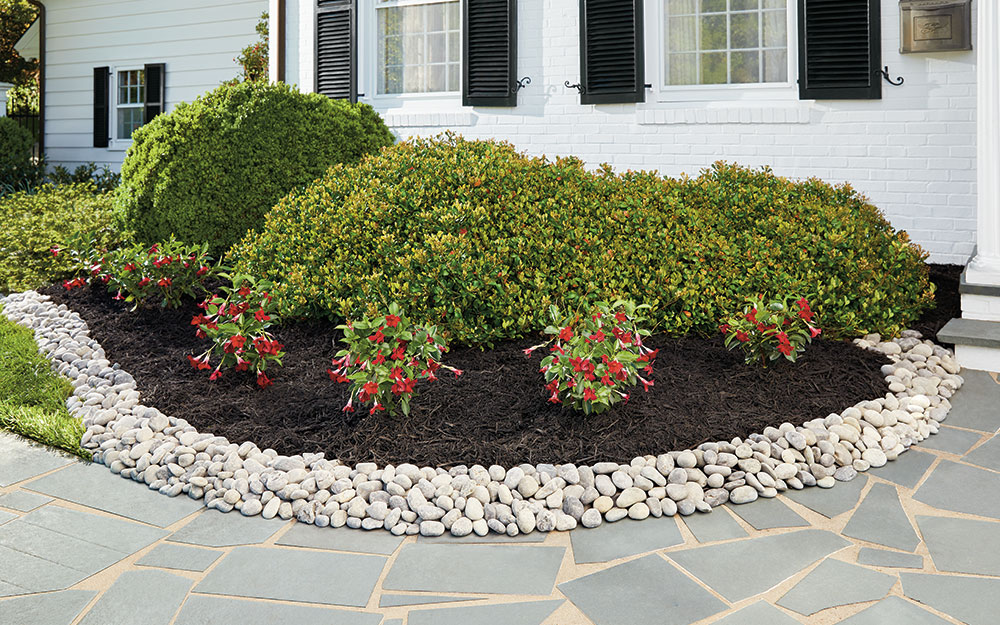Using rocks in your front yard landscaping is a gorgeous yet low-maintenance way to add visual interest. The textures and colors of diverse rock materials create striking focal points and complement greenery.
Benefits of incorporating rocks in front yard designs:
- Provide unique color and texture
- Create beautiful rock gardens and pathways
- Help define spaces as edging or borders
- Work well on hills and slopes for stability
- Offer a budget-friendly alternative to high-maintenance lawns
This guide covers everything from rock types to creative layouts for a showstopping rock yard makeover:
- Materials like river rock, gravel, boulders, and more
- Innovative rock landscaping concepts
- Combining rocks with other elements like mulch
- Layout and placement strategies
- Caring for your new rock landscape
Let’s get ready to rock your front yard to the next level! Your neighbors and guests will be stunned by your new curb appeal.
Materials to Use for Rock Landscaping
River Rocks
- Smooth, rounded shape
- Varying sizes available
- Natural color variations
- Great for walkways, borders, beds
Landscape Boulders
- Really large rocks!
- Add height and drama
- Natural shapes and textures
- Use as focal points and elevation
Gravel
- Small loose rocks
- Comes in different sizes
- Easy to spread as groundcover
- Use for patios, driveways, paths
Crushed Stone
- Angular gravel made from quarried stone
- Compacts well for paths and driveways
- Decorative and functional
Pavers
- Interlocking blocks for patios and walks
- Combine with gravel or stone for texture
- Formal look, available in patterns
Mixing different rocks and hardscapes creates cool contrasts! Don’t be afraid to get creative. Next we’ll look at how to incorporate them into eye-catching designs.
Benefits of Using Rocks in Front Yard Landscaping
Before jumping into the specific landscaping ideas, let’s look at some of the top reasons you should consider using rocks in your front yard design:
- Low maintenance – Rocks are an inert material that don’t require regular pruning, watering, or any other care. This makes them ideal for low maintenance yards.
- Budget friendly – Landscaping rocks are one of the most affordable hardscaping materials. They provide a lot of bang for your buck.
- Long lasting – Rocks are extremely durable and will last for years in your landscape without decomposing. This is a big advantage over mulch and other organic materials.
- Drought tolerant – Rock beds don’t need irrigation. This helps conserve water, which is especially beneficial in dry climates.
- Versatile – Rocks come in so many sizes, shapes, colors and textures. This versatility allows you to get really creative with your design.
- Provide structure – Large boulders can act as edging for garden beds and pathways. Stacked rocks can form walls and other structural features.
- WEed control – A thick layer of rocks acts as a weed barrier, reducing unwanted growth.
- Low fire risk – Unlike wood mulch, rocks won’t burn or pose a fire hazard.
With all these advantages, it’s easy to see why incorporating rocks should be a part of your front yard landscaping plans. Now let’s get into the inspiring design ideas!
1. Mix Smooth River Rocks and Weathered Boulders
This eclectic design includes a mix of rocks for visual interest. Smooth, rounded river rocks offer a colorful contrast to the weathered grey boulders. Using a variety of rocks prevents a monotonous look. The river rocks surround the tree and boulders help create separation between landscaping spaces.
2. Line the Walkway with White Rocks
For a crisp, clean look, flank a front walkway or driveway with bright white rocks. Poplar, dogwood and other ornamental trees provide vertical interest. The white rocks complement the home’s exterior as well as the green lawn.
3. Use Large Boulders for Stairs
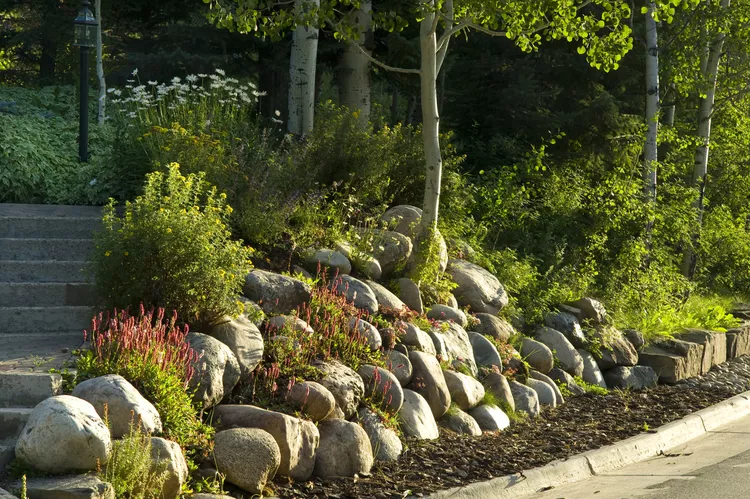
In a hilly or sloped yard, large boulders can be used to form rustic stairs leading to the front door. This helps create a walkway while also dealing with grade changes. For added safety, you can fill the gaps between boulders with small gravel.
4. Create Contrast with Red Lava Rock
Red lava rock offers eye-catching contrast when paired with emerald green grass. Use it to edge garden beds or as filler around larger boulders. The red pops against the home’s neutral exterior. Evergreen shrubs and ornamental grasses add texture.
5. Line the Driveway with River Rock
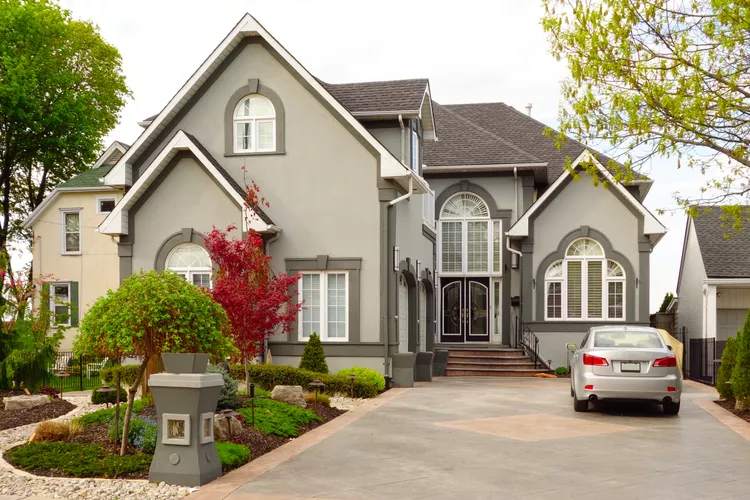
River rock comes in serene blues, earthy browns and other colors to complement your home. Using it to line your driveway and front walkway can nicely tie the hardscape together. The smooth, rounded shape feels naturalistic yet refined.
6. Use Large Boulders as Focal Points
Incorporate a few oversized boulders to create focal points in your front yard landscape. Boulders draw the eye with their bold shape and presence. Arrange them in key spots you want to highlight. Combine with grasses, shrubs and mulch beds.
7. Accent With Gravel Garden Paths
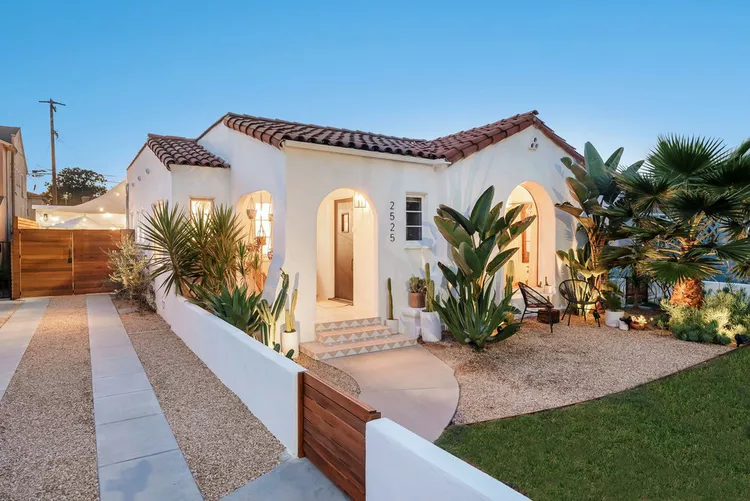
Winding gravel garden paths make for an intriguing landscape feature. The crunchy gravel also creates textural contrast from the lawn and garden beds. Use landscape edging to keep the gravel path contained. A focal boulder draws attention.
8. Go for Drama With Stacked Stone Walls
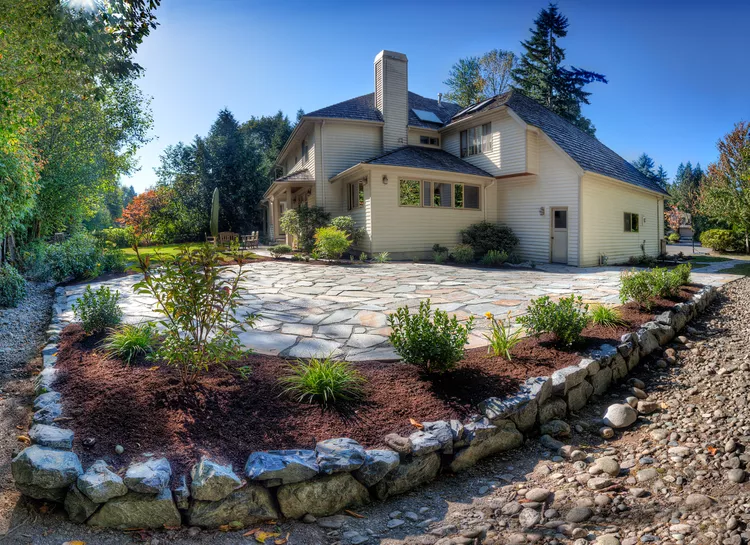
Stacked stone walls look striking when incorporated into landscaping. Use them to edge planting beds, divide spaces, or frame the yard as seen here. The linear pattern adds geometric structure as well. Choose locally quarried stone for a natural look.
9. Softscape With Blue Rocks
Soften the hard lines of your home with blue decorative rocks. Their cool tones are calming and complement foliage. Use the rocks as edging and scatter them throughout garden beds. Blue rocks also parallel a blue front door.
10. Create a Rock Garden
Rock gardens are on-trend for their minimal maintenance and natural beauty. Arrange rocks of different sizes, shapes and colors for visual diversity. Leave some open space between rocks to allow for soil and short native plants. Go for a pleasing design.
11. Use Large Pavers as Stepping Stones
Guide guests to your front door with oversized natural stone pavers serving as stepping stones. Their substantial size makes a statement while providing safe footing. Keep them in a narrow pathway through lush garden beds and lawn.
12. Add Warmth With Desert Landscaping
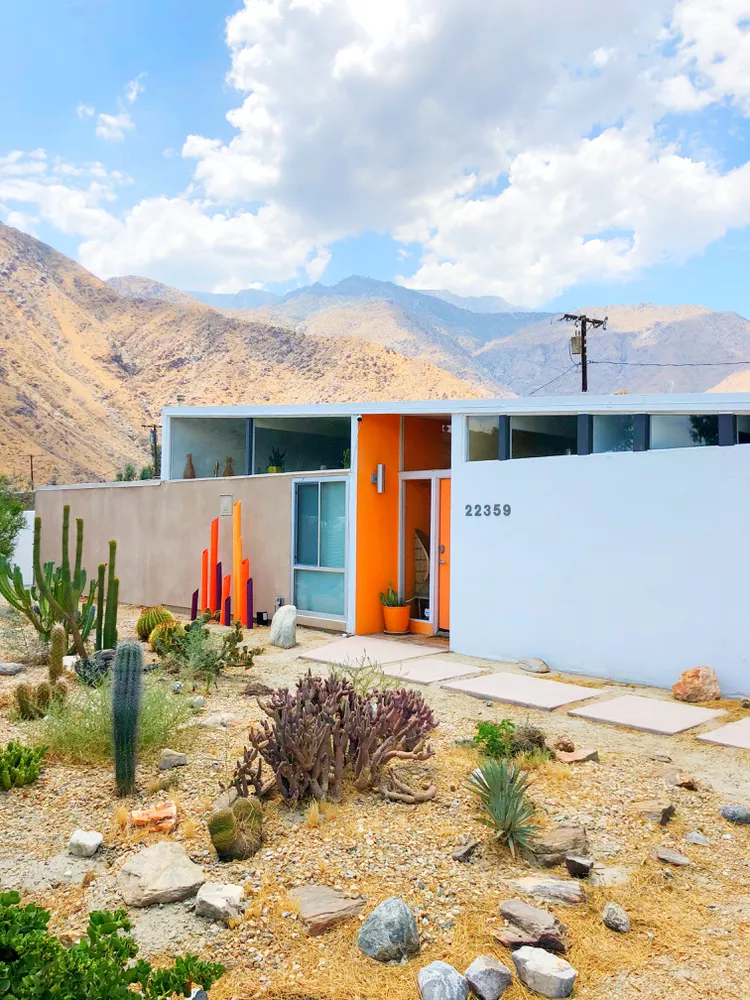
In arid climates, incorporate desert landscaping with rocks, gravel, cacti, and succulents. Mix various rock sizes and colors for warmth and texture. Keep the palette natural using earth tones with pops of green from drought-tolerant plants.
13. Line the House Foundation with River Rock
Using river rock to line your home’s foundation disguises the foundation itself while complementing the architecture. The neutral brown stones blend with the exterior while the organic shapes soften the home’s lines. A neat edge keeps them contained.
14. Go Monochrome with White Quartz
For a contemporary look, opt for visually clean white quartz gravel as a neutral base. The white rocks act as a canvas to let colorful plants make a statement. Their monochromatic color ties everything together elegantly.
15. Add Whimsy with Painted Rocks
Personalize your landscape with painted rocks mixed in. Go for fun patterns, your home’s address number or names of family members. Incorporate the painted rocks along borders, in flower beds and surrounding trees. They show personality.
16. Pair Purple Rocks with Lavender Plants
Choose rocks in harmonizing shades of purple and pair them with flowers like lavender and salvia for a cohesive color scheme. The purple tones are soothing and sophisticated. Scatter the rocks throughout for a pulled-together look.
17. Contrast Rocks with Green Foliage
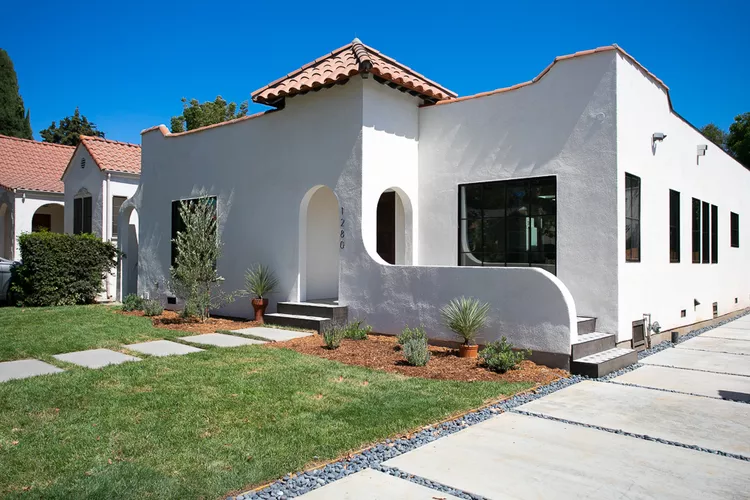
Variegated leaves, feathery grasses and other green foliage look extra vivid when contrasted with grey and earth-toned rocks. The green really pops against neutrals. Use smooth, rounded rocks to complement the plants’ organic shapes.
18. Go for Multi-Colored Mosaic Rocks
For serious curb appeal, opt for multi-colored mosaic garden rocks. Their patchwork colors inject vibrant personality into your landscape. Use them as edging, pathways or decorative ground cover. They also pair well with colorful blooms.
19. Create Seating Areas with Boulders
Large boulders can double as unique garden seating when arranged in clusters. Their natural look is inviting and they provide built-in spots to relax outdoors. For comfort, top the boulders with cushions that complement your color scheme.
20. Use White Rocks to Brighten Shady Areas
Bright white rocks reflect light, helping to brighten shady areas of your landscape. Use them under trees, by your home’s foundation and in other dim spots that need a pick-me-up. Dress them up with ferns, hostas and other shade-loving greenery.
21. Complement Architecture with Modern Rock Beds
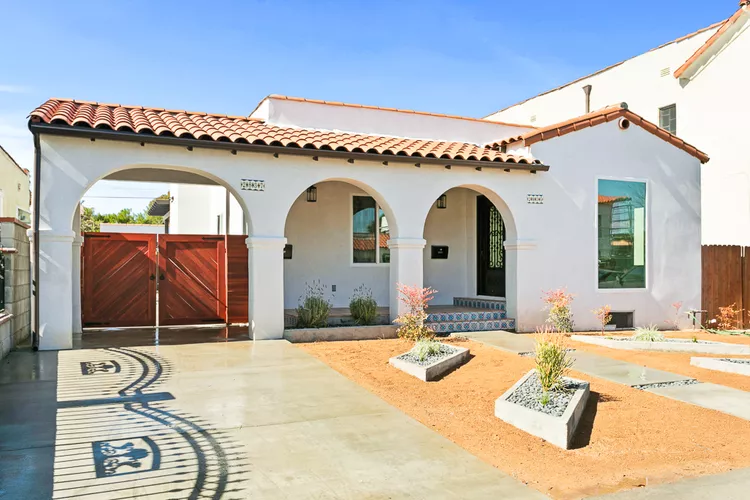
Clean-lined, organic shaped boulders and rocks match well with modern architecture. The simple rock compositions mirror mid century and contemporary home styles. Allow some open space between rocks for a minimalist look.
22. Add Rock Wall Planters for Vertical Greenery
Rock wall planters merge the beauty of rocks and plants. Stack rocks securely, leaving room for soil and plants in the openings. Then plant cascading greenery like ivy or succulents. The wall lifts plants up for vertical interest.
23. Use Rocks for Drainage in Rain Gardens
Rain gardens use water-loving native plants and rocks to soak in runoff. The rocks improve drainage while adding organic-looking texture. Use river rock and pea gravel around plantings. The rocks move and shift with the water flow.
24. Combine Large Pavers and Pebbles
Bluestone pavers leading to the entry make a bold
Placement Tips and Layout Inspiration
We’ve got our rocks, now let’s chat about how to artfully place them in your front yard for maximum visual impact!
Front Walkways
- Line the sides of walkways with boulders or gravel
- Use pavers inset with pebbles for texture
- Flank with colorful plants for contrast
Slopes and Hills
- Use large boulders to create steps on inclines
- Retaining walls hold back slopes beautifully
- Gravel is great for erosion control on hills
Driveways
- Extend crushed stone or pebble beds from the driveway
- Frame driveway edges with lined boulders
- Repeat driveway paver patterns in garden beds
Defining Zones
- Use gravel, stone or pavers to differentiate areas
- Transition materials between spaces
- Connect zones with pedestrian rock pathways
Caring for and Maintaining Rock Landscapes
Let’s chat about keeping your new rock landscape looking fabulous. With some simple care, your rocks will shine for years!
Preventing Weed Growth
- Use landscape fabric under rocks to block weeds
- Apply natural pre-emergent herbicide regularly
- Hand pull small weeds quickly to stop spreading
Replenishing Displaced Rocks
- Rake stray rocks back into beds after heavy rain
- Check for low spots monthly and add more rocks
- Consider using edging to keep rocks contained
Power Washing
- Blast away debris and dirt buildup seasonally
- Scrub oil stains on driveway pavers as needed
- Take care around delicate plants and trees
Using Rocks Safely
- Smooth sharp edges on pavers
- Opt for rounded pea gravel near play areas
- Apply sealant to enhance traction if needed
With some periodic TLC, your rock features will stay pristine-looking for years! Maintaining your new landscape takes minimal effort.
28 Beautiful Front Yard Landscaping Ideas With Rocks and Mulch Video
FAQ
How do you landscape a front yard for beginners?
How do you arrange rocks in landscaping?
Are rocks good for front yard landscaping?
Rocks are also a key component in many other front yard landscaping ideas, from dry gardens, drought tolerant and desert schemes to Japanese and Mediterranean-style front spaces. It’s also a great idea to combine rocks with gravel if you’re digging up your front yard lawn and looking for easy low-maintenance replacement ideas.
How many front yard landscaping ideas with rocks?
12 Front Yard Landscaping Ideas With Rocks [Easy, Actionable Ideas!] Using a variety of different rocks in your front yard gives you the ability to create some amazing landscaping designs. You can easily create some very formal landscapes as well as use the rocks in different ways to create a more natural and flowing landscape.
How to choose a rock front yard landscape design?
When browsing landscape photos, think about curb appeal above all else; Rock Front Yard landscape designs are your chance to make a great first impression. A flower garden is a great option, but if ongoing care is a concern, you can simplify the process by opting for low-maintenance succulents, bushes or hedges instead.
Should you add rocks to a front yard?
Adding rocks to plant beds helps suffocate weeds and keeps topsoil in place. A sloped front yard is a great opportunity to create a stunning garden. This sloped yard features boulders to help level the garden while also adding a one-of-a-kind design feature.
How much do landscaping rocks cost?
This varies greatly, but expect $3-6 per sq. ft. on average. Smaller gravel is cheapest, while large boulders are priciest. Calculate your sq. footage to budget accordingly.
How do I calculate how many rocks I need?
- Measure the area length x width in feet
- Multiply length x width for total square footage
- Multiply square footage by depth in feet
- Divide total by 27 to get cubic yards of rocks needed
What can I put under landscaping rocks?
It’s best to lay down landscape fabric or newspaper first to block weeds and keep rocks contained. Plastic edging also helps retain them.
How often do I need to replace landscape rocks?
Rocks last for many years, unlike mulch. Replenish displaced rocks annually, and add a fresh layer every 3-5 years as they settle.
What are the best rocks for drainage?
Gravel and crushed stone compact well while allowing water to flow through easily. For dry creek beds, use larger river rocks.
- The Ultimate Guide to Growing Strawberries in Raised Beds - August 8, 2025
- No-Dig Garden Beds: The Easiest Way to Grow a Beautiful Garden - August 6, 2025
- How to Protect and Preserve Wood for Raised Garden Beds - August 6, 2025

